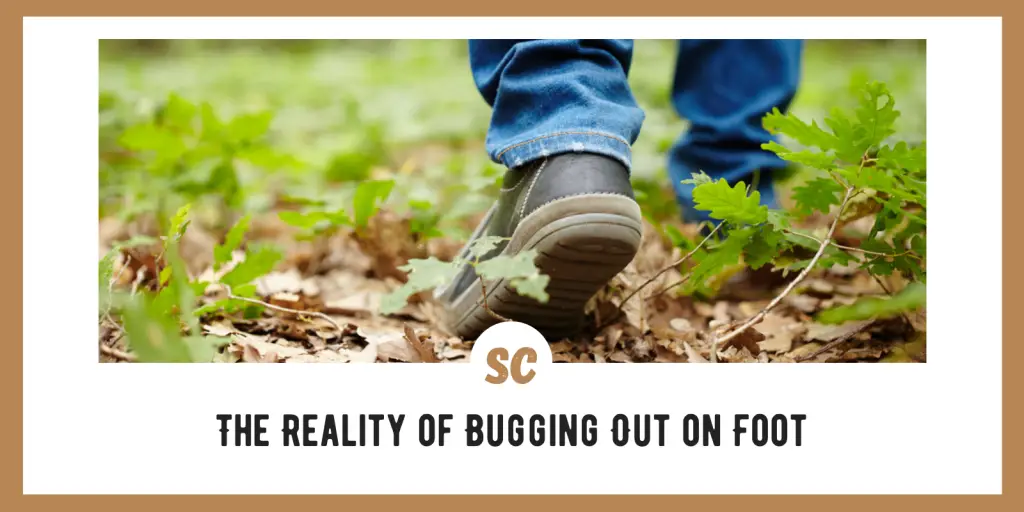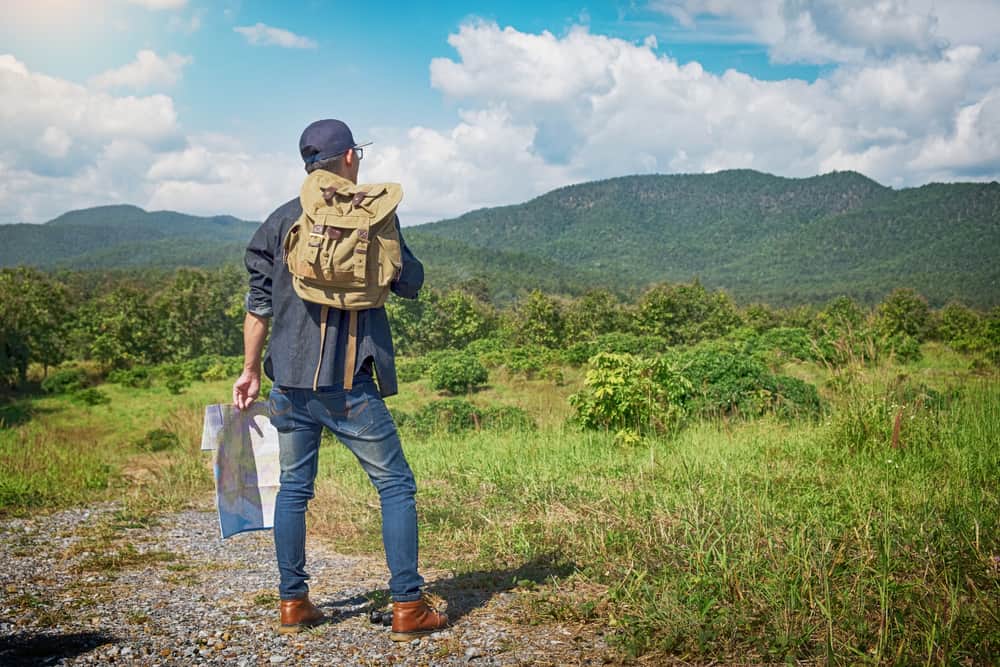Within the emergency preparedness and survival community, there are quite a few topics, methods, and overall advice that are taken at face value. While there is plenty of information that can be taken this way, we must always have our critical skills hat on.
One topic that this pertains to is bugging out, specifically bugging out on foot. Bugging out has been popularized by television, movies, and other media sources. It is usually portrayed as exciting and to some extent easily. Neither could be further from the truth.
Most people tend to think of bugging out as their first course of action when in reality it is going to be the last and least desirable option, especially if it has to be done on foot. Let’s break this apart and look at the reality of bugging out on foot and why most people probably won’t do it or may not succeed.
SKIP AHEAD
Reasons Bugging Out On Foot Sucks
Poor Planning
A well-thought-out bug-out plan is just as important if not more important than all other plans. This is because a person is leaving their comfort zone and most of their resources behind.
Yet, time and time again, when asked about their bugout plan, I have heard people respond simply with, “I’ll grab my bag and head off to safety,” or “the hills.” That’s fine and dandy and when the need to escape an immediate danger arises, but what then? Answers like the above leave a lot to be desired.
There are a ton of questions that people need to answer and plan for as it relates to bugging out on foot. Here are just a few examples.
How many safe zones or bugout locations have you planned for? Most people only have one, but you should plan on at least three. That way if one location is compromised you won’t be standing around wondering what to do.
Have you planned for different routes to the various safe zones? At a minimum, you should plan on two different routes to each safe area. One route from your home and one route from your workplace. This is because these are the two locations that a person spends most of their time at.
Supplies
Bugging out on foot is going to drastically decrease the number of available resources. I would say that the average person easily has hundreds of pounds of water, food, first aid supplies, clothes, hygiene items, and an array of other tools in their home.
When it comes time to bug out almost all of that is going to be left behind. It is generally recommended that the average adult creates a bugout bag that is no more than fifty pounds, although it will most likely be less than that.
At this point, some people will say, “I have a stocked up bugout location so it’s no big deal what I leave behind or what I carry.” There are two problems with relying on a stocked bug out location.
First, you have to get there. How far away is the bugout location and what if it takes you much longer to get there than you thought, or what if something happens along the way and you can no longer get there?
Secondly, and people don’t tend to think about this one, what if your bugout location has become compromised and was broken into? Vacation properties, cabins, and the like are broken into and ransacked all the time because people know they are not lived in permanently.
Bugging out on foot requires a long-term mentality and most people just are not up for that.
Rate of Travel
People overestimate their rate of travel all the time and therefore the timetables that are in place are unrealistic. Let’s break this down a bit.
Let’s say your safe zone is 30 miles away. According to the internet, a person’s average walking speed is between 3-4mph. At 4mph a person could travel that distance in 7.5 hours. At 3mph a person could travel that distance in 10 hours. So, if your bugout location is 30 miles away, you can easily walk there within half a day, right? Wrong.
Those walking speeds are too high because several factors have not been considered.
3mph is a brisk walk and 4mph is borderline jogging. If you do not believe me then hop on a treadmill and try those speeds out for yourself. Most people do not walk at a sustained speed of 3mph. It’s closer to 2mph and even as low as 1.5mph.
Most people also do not walk while carrying a load. Carrying a fifty-pound bugout bag is tiresome and will drastically slow a person down.
Rest periods will also need to be taken and accounted for unless of course, you were planning on walking for thirty miles nonstop.
Travel rates will also be determined by the size of your group and its members. Individuals on both ends of the age spectrum as well as any injured parties will slow the group down.
These plans are often based on using map directions from the internet. Internet directions rely on taking the shortest route possible and do not account for the terrain. There will be times that walking on the main road is not possible or would be dangerous to do so.
Traveling cross-country may be a shorter distance but the terrain will certainly slow a group down.
Lastly, the weather conditions must also be considered. Walking through deep snow will almost bring a group to a standstill. Walking in the rain is usually not desirable so travel will stop to seek shelter. Extremely hot weather will slow a group down so that many breaks can be taken for cooling down.
Just based on normal and realistic walking speeds, a person should plan for a rate of travel of 1.5mph and 2mph per hour at best. This means the 30-mile distance can be covered in 15-20 hours and not 7.5-10 hours.
However, this doesn’t take into account the other factors that were listed, and I would say planning on walking ten miles per day is a more realistic goal. So, the original plan of walking 30 miles in under half a day has turned into a three-day hike.
Overestimating how quickly you can walk a distance is poor planning because it mainly affects the number and type of supplies you really need. Not to mention how it affects morale when it takes a group several times longer to reach a destination than anticipated.
Health
This is a category that I think people are the least realistic and honest about because we all like to think that we are more capable than we may be.
That 30-mile journey I just talked about; sure I can do it! Nobody likes to think they can’t do it because it may be embarrassing, or it lets others or yourself down by admitting otherwise.
Planning on bugging out on foot in your head is easy. Doing so in real life is an entirely different animal. Our modern lifestyle is one of convenience which breeds inactivity.
Also, we must consider age and health conditions. Are you going to expect your eighty-year grandmother or someone with a heart condition or bad diabetes to bug out on foot?
Trying to traverse uneven terrain during harsh weather conditions is going to prove exceedingly difficult for many people because they are just not physically capable of handling it.
Zero Protection
Protection and security are other issues to think about when bugging out on foot. Bugging out in a vehicle, such as a car or truck, provides at least some physical protection from the elements and other possible threats.
Yes, you may have a tent or some pop-up structure that can be used to get out of bad weather for a bit, but generally speaking, bugging out on foot leaves you wide open to a range of dangers.
FAQs
You should bug out on foot if there is an imminent danger and other forms of transportation are unavailable, if staying in your current location will prove more dangerous than leaving, and if all your supplies have been exhausted.
It’s not so much that it is bad, but it is certainly an undesirable option. Primarily because it is exhausting work, less supplies are available, and you are exposed to more dangerous situations.
Only if there is imminent danger. Otherwise, running is not advised because it will require more energy and increase the chance of injury.
They can, but they should not. Walking barefoot across different terrains when your feet are accustomed to shoes will lead to injury. If your feet become injured then you cannot walk.
Wrap Up
I would like to end this article by saying that everything I discussed applies to me and I am not sitting on some pedestal preaching about something you cannot do. I would avoid bugging out on foot at all costs but if I must, I understand the reality of it.
At some point, bugging out on foot may be something you have to do but we have to be honest about it if we are to succeed. My best piece of advice for successfully bugging out on foot is twofold. Plan realistically and start becoming healthier now.
Thanks for reading and stay prepared.
If you have any questions or thoughts on bugging out on foot, be sure to sound off in the comment section below and let us know!




